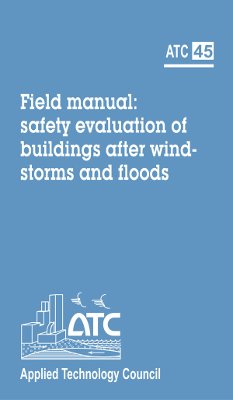
Field Manual: Safety Evaluation of Buildings after Windstorms and Floods
Product Code/ISBN: ATC45
Original price
$47.95
-
Original price
$47.95
Original price
$47.95
$47.95
-
$47.95
Current price
$47.95
This guide will help you assess whether buildings that are damaged or potentially are damaged can still be used or if they need to be restricted. This is a perfect help guide for building inspectors, engineers, or any other field that checks the safety of buildings. All the information is presented to you in a handy pocket guide format.
Table of Contents
Preface
List of Figures
List of Tables
- Introduction
- Purpose and Scope
- Report Contents and Organization
- Overview of Building Safety-Evaluation Procedures
- Basic Building Safety-Evaluation Procedures
- Other Inspection Consideration
- Personnel Requirements
- Geotechnical Conditions
- Hazardous Materials
- Right to Inspect
- Posting Categories
- Posting Criteria
- Evaluation Forms
- Posting and Barricading Procedures
- Changing Posting Classification
- Use of Judgment Required
- Rapid Evaluation Procedure
- Introduction
- Rapid Evaluation Criteria
- Rapid Evaluation Damage Assessment
- Examples of Building Postings
- Difficult Posting Decisions
- Substantial Damage Determination
- Inspection Process
- Detailed Evaluation and Posting of Wind-Damaged Buildings
- Introduction
- Building Categories
- Low-Rise Residential Buildings
- Low-Rise Commercial Buildings
- Mid-Rise and High-Rise Commercial Buildings
- Detailed Postwind Evaluation Criteria
- Detailed Postwind Evaluation Procedure
- Building System Considerations
- Inspection Process
- When the Structural System is not Viewable
- Detail Evaluation and Posting of Flood-Damaged Buildings
- Introduction
- Building Classification for Flood Damage Evaluation
- Typical Building Damage
- Damage Due to Inundation and Hydrostatic Forces
- Damage Due to Velocity (Hydrodynamic Forces)
- Damage Due to Waves
- Damage Due to Erosion and Scour
- Damage Due to Other Geological Conditions
- Detailed Postflood Evaluation Criteria
- Detailed Postflood Evaluation Procedure
- Building System Considerations
- Inspection Process
- When the Structural System is Not Viewable
- Detailed Evaluation and Posting of Nonstructural Hazards
- Introduction Evaluation Criteria
- Essential Facilities – Operational Considerations
- Engineering Evaluation Method
- Field Safety for Inspectors
- Safety in the Field
- Hazardous Materials
- Recognition of Hazardous Materials
- Actions to be Taken
- Field Equipment
- Human Factors Following Disasters
- Introduction
- Dealing with the Owners of Damaged Property
- Coping with Stress in the Field
Appendix A: Project Participants
Appendix B: Evaluation Forms and Posting Placards
Appendix C: Example 1 – Rapid Evaluation
Appendix D: Example 2 – Detailed Evaluation
Appendix E: Guidance for Owners and Occupants of Damaged Buildings
References
Illustration Credits
